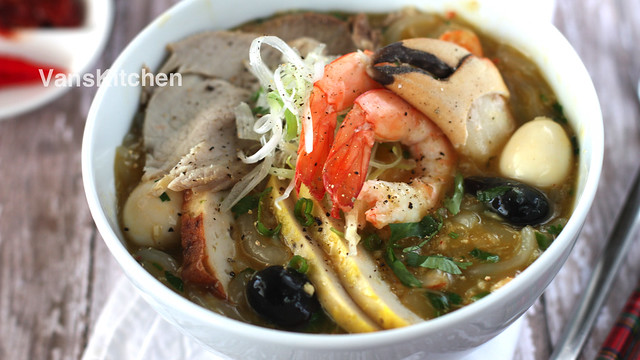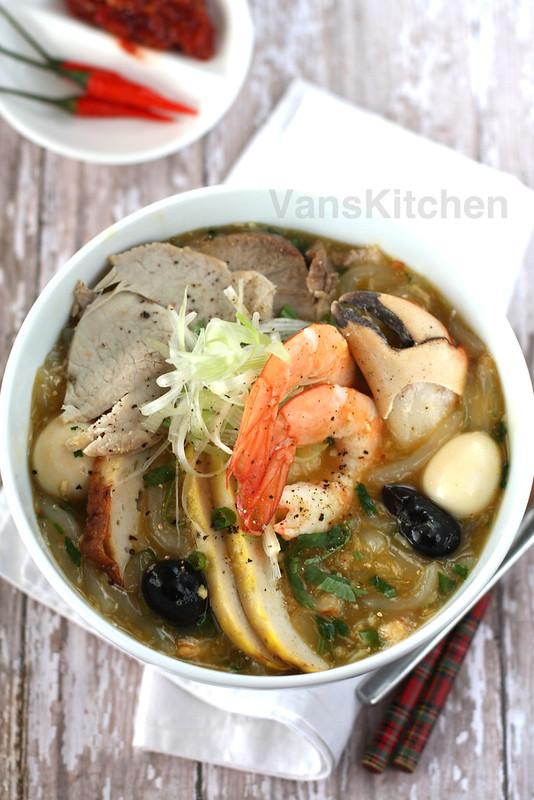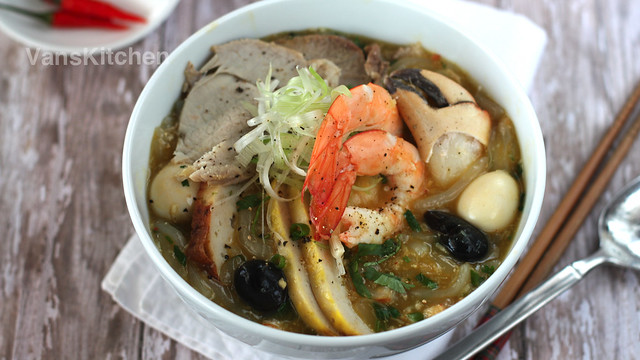Blog in Vietnamese: Video cách làm bánh canh cua
This Vietnamese crab noodle soup is authentic and very tasty. You'll love the way it warms you up during the cold winter months. If you have trouble making all of the toppings, don't get discouraged. As long as you get in the essentials like the crab meat and noodles, it will still turn out great. Enjoy!
Ingredients:
Noodles:
(4 portions)
2¼ cup (200 g) rice flour
½ cup (70 g) tapioca flour (plus a bit for dusting)
¼ tsp salt
¾ cup ~ 1¼ cup boiling water
Broth:
(makes 5~7 quarts)
Carcasses from 2 chickens
1 lbs pork neck bones
2 onions, grilled until smell good
2 medium dried squid, grilled until smell good
1 large daikon, peeled, cut into thick cubes
a bunch of cilantro, washed (use stems only)
0.70 oz (20 g) rock sugar
salt
pepper
Thick noodle soup and toppings:
(4 portions)
1 4.25-ounce can snow crab meat
4~8 crab claws, cooked or steamed
8 large shrimp, washed well
4 oz boneless pork shank, tied with twine;
a dozen quail eggs, boiled & peeled
1 15-ounce can of straw mushroom, drained well
fish cake, sliced into serving size (Watch the video how to make fish cake here)
annatto oil (optional)
chopped green onion
chopped cilantro leaves
green onion (use white part for garnish)
1 garlic clove, chopped
pepper
fresh chili (optional)
Instructions: Watch video how-to make Bánh canh cua step-by-step here.
Making the broth:
Clean all the bones in boiling water, rinse well again with boiling water. Then put the bones in a large stock pot. Add daikon, cilantro stem, onion, squid, rock sugar, salt, pepper and cover with water. Bring to a boil and reduce the heat to bring the stock to simmer. Simmer uncovered at least 4 hours; occasionally skim off the foam that comes to the surface. Remove the bones and strain the stock.
- If you want to add more volume to the broth while it’s simmering, add boiling water instead of cold water.
Making the noodles:
Mix together rice flour, tapioca flour, and salt. Add boiling water and start to mix. The dough will look crumbly at first, keep mixing until all the flour is moistened and becomes elastic. Cover and let the dough rest for 15 ~ 30 minutes. Then transfer the dough onto a floured working surface. Dust the roller as well to prevent sticking, and start to roll out the dough to a thickness of 3 mm. Then cut into strips of noodles. Cover and set aside.
Preparing the toppings:
Boil the shrimp in the broth until the shrimp turns pink. Take out and put in a bowl of cold water, then peel.
Poach the pork shank in the broth until it’s done. Transfer into a bowl of cold water, then slice thinly.
Slice the white part of the onion thinly, and place in ice water until it’s ready to use.
Making thick noodle soup:
In a fry pan, heat the oil and sauté the garlic until it turns light brown. Add the crab meat, and sauté until it smells good. Add straw mushroom, stir well then remove from the heat.
Strain the broth into a saucepan, add the sautéed crab meat, mushroom, and quail eggs. Bring to a boil and let it boil for few minutes. Drop the noodles in, stir often to prevent burning at the bottom. Skim off the foam that comes to the surface. Add annatto oil if you want. Cook until the noodles become transparent, and float to the surface. Taste and add more salt if necessary. Add cilantro and green onion. Mix well then remove from the heat. Transfer into serving bowl. Top with the fish cake, sliced pork, crab claw, onion, and shrimp.
Sprinkle with black pepper and serve.
Xin mời (^o^)
 ♥Here are a few of the tools I used in the video:
♥Here are a few of the tools I used in the video: Victorinox 8-Inch Chef's Knife



I have a Cuisinart Food Processor and just bought a Kitchen Aid Stand Mixer to try some of your recipes. Would you please mention what attachment to use for each machine and especially how long and at what speed for each process so I and many others who have these machines can put them at use, please.This is 1 of the reasons I like your blog.
ReplyDeleteThe root is what's used to make jellies and flours. This flour is what is used to make these noodles. It has been used in Eastern Asia for centuries as a main staple in the diets of many cultures. The yam noodle may be better known in America as the Shirataki noodle. Japanese Food Toronto
ReplyDelete